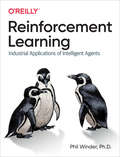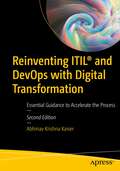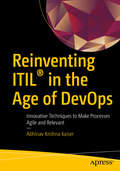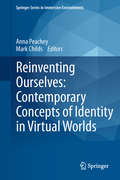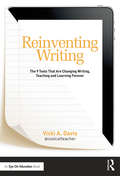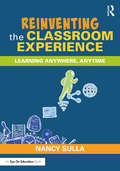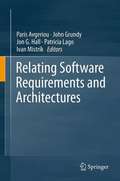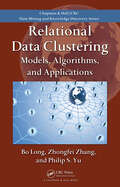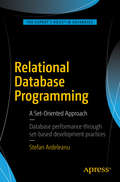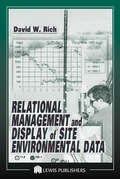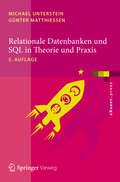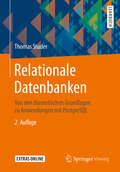- Table View
- List View
Reinforcement Learning: Industrial Applications Of Intelligent Agents
by Phil WinderReinforcement learning (RL) will deliver one of the biggest breakthroughs in AI over the next decade, enabling algorithms to learn from their environment to achieve arbitrary goals. This exciting development avoids constraints found in traditional machine learning (ML) algorithms. This practical book shows data science and AI professionals how to learn by reinforcement and enable a machine to learn by itself.Author Phil Winder of Winder Research covers everything from basic building blocks to state-of-the-art practices. You'll explore the current state of RL, focus on industrial applications, learn numerous algorithms, and benefit from dedicated chapters on deploying RL solutions to production. This is no cookbook; doesn't shy away from math and expects familiarity with ML.Learn what RL is and how the algorithms help solve problemsBecome grounded in RL fundamentals including Markov decision processes, dynamic programming, and temporal difference learningDive deep into a range of value and policy gradient methodsApply advanced RL solutions such as meta learning, hierarchical learning, multi-agent, and imitation learningUnderstand cutting-edge deep RL algorithms including Rainbow, PPO, TD3, SAC, and moreGet practical examples through the accompanying website
Reinventing Clinical Decision Support: Data Analytics, Artificial Intelligence, and Diagnostic Reasoning (HIMSS Book Series)
by Paul Cerrato John HalamkaThis book takes an in-depth look at the emerging technologies that are transforming the way clinicians manage patients, while at the same time emphasizing that the best practitioners use both artificial and human intelligence to make decisions. AI and machine learning are explored at length, with plain clinical English explanations of convolutional neural networks, back propagation, and digital image analysis. Real-world examples of how these tools are being employed are also discussed, including their value in diagnosing diabetic retinopathy, melanoma, breast cancer, cancer metastasis, and colorectal cancer, as well as in managing severe sepsis. With all the enthusiasm about AI and machine learning, it was also necessary to outline some of criticisms, obstacles, and limitations of these new tools. Among the criticisms discussed: the relative lack of hard scientific evidence supporting some of the latest algorithms and the so-called black box problem. A chapter on data analytics takes a deep dive into new ways to conduct subgroup analysis and how it’s forcing healthcare executives to rethink the way they apply the results of large clinical trials to everyday medical practice. This re-evaluation is slowly affecting the way diabetes, heart disease, hypertension, and cancer are treated. The research discussed also suggests that data analytics will impact emergency medicine, medication management, and healthcare costs. An examination of the diagnostic reasoning process itself looks at how diagnostic errors are measured, what technological and cognitive errors are to blame, and what solutions are most likely to improve the process. It explores Type 1 and Type 2 reasoning methods; cognitive mistakes like availability bias, affective bias, and anchoring; and potential solutions such as the Human Diagnosis Project. Finally, the book explores the role of systems biology and precision medicine in clinical decision support and provides several case studies of how next generation AI is transforming patient care.
Reinventing Higher Education: The Promise of Innovation
by Ben WildavskyThe inspiration for this timely book is the pressing need for fresh ideas and innovations in U.S. higher education. At the heart of the volume is the realization that higher education must evolve in fundamental ways if it is to respond to changing professional, economic, and technological circumstances, and if it is to successfully reach and prepare a vast population of students—traditional and nontraditional alike—for success in the coming decades. This collection of provocative articles by leading scholars, writers, innovators, and university administrators examines the current higher education environment and its chronic resistance to change; the rise of for-profit universities; the potential future role of community colleges in a significantly revised higher education realm; and the emergence of online learning as a means to reshape teaching and learning and to reach new consumers of higher education. Combining trenchant critiques of current conditions with thought-provoking analyses of possible reforms and new directions, Reinventing Higher Education is an ambitious exploration of possible future directions for revitalized American colleges and universities.
Reinventing ITIL® and DevOps with Digital Transformation: Essential Guidance to Accelerate the Process
by Abhinav Krishna KaiserThe second edition of this book has been fully updated to show how the DevOps way of working has continued to adapt to changing technologies. The ITIL processes which were an integral part of the DevOps world have been merged with the DevOps framework, reflecting the current emphasis on product models rather than viewing project and support models separately. This book starts with the basics of digital transformation before exploring how this works in practice: that is, people, processes and technology, and org structures. It delves into value streams that are the basis for ITIL and DevOps, highlighting the differences between the methods of the past and new methodologies needed to ensure products to meet contemporary expectations. This updated edition includes new chapters that discuss digital transformation for business success, introduce the battle tank framework, leading people in the digital world, managing work in a remote working model, and the product-led transformation model. These new chapters provide the guidance necessary to move beyond DevOps into a holistic digital transformation exercise.The ideas, recommendations, and solutions you'll learn over the course of this book can be applied to develop solutions or create proposals for clients, and to deliver seamless services for DevOps projects.What You Will LearnUnderstand digital transformationLeverage the battle tank framework for digital transformationGain insight into the confluence of DevOps and ITILAdapt ITIL processes in DevOps projectsMove organizations from a project to a product-led model Lead teams in a digital worldManage the work of remote teamsWho This Book Is ForIT consultants and IT professionals who are looking for guidance to strategize, plan and implement digital transformation initiatives; design and redesign ITIL processes to adapt to the digital ways of working; moving organizations to product-led business; and leading people and managing work in the digital age.
Reinventing ITIL® in the Age of DevOps: Innovative Techniques To Make Processes Agile And Relevant
by Abhinav Krishna KaiserDelve into the principles of ITIL® and DevOps and examine the similarities and differences. This book re-engineers the ITIL framework to work in DevOps projects without changing its meaning and its original objectives, making it fit for purpose for use in DevOps projects. Reinventing ITIL® in the Age of DevOpsshows you the relevance of ITIL since the emergence of DevOps and puts a unique spin on the ITIL service management framework. Along the way you will see that ITIL is a mature service management framework and years of maturity will be lost if it’s made invalid. The ideas, recommendations, and solutions provided in Reinventing ITIL in the Age of DevOps can be leveraged in order to readily develop solutions or create proposals for clients. The ideas in this book can be further expanded to deliver seamless services to DevOps projects. What You Will LearnDiscover the basics of ITIL and DevOpsCompare ITIL and DevOpsUnderstand the structure of a DevOps organization and adapt the ITIL roles to this structureRe-engineer ITIL for DevOps projectsImplement major processes such as incident management, configuration management, and change management processes in DevOps projectsAutomate activities within processesWho This Book Is For Consultants, business analysts, administrators, and project managers who are looking for more information about Dynamics 365.
Reinventing Ourselves: Contemporary Concepts of Identity in Virtual Worlds
by Anna Peachey Mark ChildsThe proposed book explores the theme of identity, specifically as applied to its role and development in virtual worlds. Following the introduction, it is divided into four sections: identities, avatars and the relationship between them; factors that support the development of identity in virtual worlds; managing multiple identities across different environments and creating an online identity for a physical world purpose.
Reinventing Writing: The 9 Tools That Are Changing Writing, Teaching, and Learning Forever
by Vicki DavisIn this much-anticipated book from acclaimed blogger Vicki Davis (Cool Cat Teacher), you’ll learn the key shifts in writing instruction necessary to move students forward in today’s world. Vicki describes how the elements of traditional writing are being reinvented with cloud-based tools. Instead of paper, note taking, filing cabinets, word processors, and group reports, we now have tools like ePaper, eBooks, social bookmarking, cloud syncing, infographics, and more. Vicki shows you how to select the right tool, set it up quickly, and prevent common mistakes. She also helps you teach digital citizenship and offers exciting ways to build writing communities where students love to learn. Special Features:• Essential questions at the start of each chapter to get you thinking about the big ideas• A chapter on each of the nine essential cloud-based tools--ePaper and eBooks; digital notebooks; social bookmarking; cloud syncing; cloud writing apps; blogging and microblogging; wikis and website builders; online graphic organizers and mind maps; and cartoons and infographics• A wide variety of practical ways to use each tool in the classroom• Alignments to the Common Core State Standards in writing • Level Up Learning--a special section at the end of each chapter to help you review, reflect on, and apply what you’ve learned• Writing tips to help you make the best use of the tools and avoid common pitfalls• A glossary of key terms discussed in the book• Useful appendices, including reproducible material for your classroom No matter what grade level you teach or how much tech experience you have, you will benefit from Vicki’s compelling and practical ideas. As she emphasizes throughout this essential book, teaching with cloud-based tools has never been easier, more convenient, or more important than right now.
Reinventing the Classroom Experience: Learning Anywhere, Anytime
by Nancy SullaLearn how to design versatile learning environments in which instruction is as effective virtually as it is in person. Bestselling author and consultant Nancy Sulla shows how you can reinvent the classroom experience and provide high-quality instruction that works as well at home as it does in school. You will discover how to help students build strong work habits and empower them to take responsibility for their learning; five key types of instructional activities; the power of PBL to increase student engagement and motivation; and five types of synchronous engagement between teachers and students. You will also gain strategies for building social and emotional learning, positioning the teacher as the facilitator of learning and parents as partners, and keeping equity at the forefront. No matter what grade level you teach or whether you are teaching fully in school, remotely, or a combination of both, this essential book will help you understand the key structures and strategies that work so students are positioned to learn anywhere, anytime.
Reinventing the IT Department (Computer Weekly Professional Ser.)
by Terry White'Reinventing the Information Technology Department' is both anecdotal and informal but deals with a subject which is of vital interest to Chief Information Officers and IT Managers, addressing questions such as:* How does the IT department keep pace with business change?* How do we provide stable and responsive IT platforms?* How do we add recognised value to the organisation?* How do I reinvent my department?* How do I get onto the board? It offers an alternative view of the new roles of the in-house IT function and proposes a rethink about IT services within companies, suggesting a self-help approach to redefining/reinventing in-house IT for CIOs.The author explains that new modes of business thinking and operation are essential if a company is to succeed in the near future and in light of this covers topics such as self-organising systems, knowledge management, multi-stakeholder perspectives, and empowerment initiatives in relation to the overall business and in particular the IT function.Each chapter contains implementation templates for the readers to take themselves through the repositioning or reengineering of the IT function and their own departments.
Reinvention of Health Applications with IoT: Challenges and Solutions (Demystifying Technologies for Computational Excellence)
by Dr A. AmbikapathyThis book discusses IoT in healthcare and how it enables interoperability, machine-to-machine communication, information exchange, and data movement. It also covers how healthcare service delivery automates patient care with the help of mobility solutions, new technologies, and next-gen healthcare facilities with challenges faced and suggested solutions prescribed. Reinvention of Health Applications with IoT: Challenges and Solutions presents the latest applications of IoT in healthcare along with challenges and solutions. It looks at a comparison of advanced technologies such as Deep Learning, Machine Learning, and AI and explores the ways they can be applied to sensed data to improve prediction and decision-making in smart health services. It focuses on society 5.0 technologies and illustrates how they can improve society and the transformation of IoT in healthcare facilities to support patient independence. Case studies are included for applications such as smart eyewear, smart jackets, and smart beds. The book will also go into detail on wearable technologies and how they can communicate patient information to doctors in medical emergencies. The target audiences for this edited volume is researchers, practitioners, students, as well as key stakeholders involved in and working on healthcare engineering solutions.
Relating Software Requirements and Architectures
by John Grundy Ivan Mistrík Jon G. Hall Patricia Lago Paris AvgeriouWhy have a book about the relation between requirements and software architecture? Understanding the relation between requirements and architecture is important because the requirements, be they explicit or implicit, represent the function, whereas the architecture determines the form. While changes to a set of requirements may impact on the realization of the architecture, choices made for an architectural solution may impact on requirements, e.g., in terms of revising functional or non-functional requirements that cannot actually be met. Although research in both requirements engineering and software architecture is quite active, it is in their combination that understanding is most needed and actively sought. Presenting the current state of the art is the purpose of this book. The editors have divided the contributions into four parts: Part 1 "Theoretical Underpinnings and Reviews" addresses the issue of requirements change management in architectural design through traceability and reasoning. Part 2 "Tools and Techniques" presents approaches, tools, and techniques for bridging the gap between software requirements and architecture. Part 3 "Industrial Case Studies" then reports industrial experiences, while part 4 on "Emerging Issues" details advanced topics such as synthesizing architecture from requirements or the role of middleware in architecting for non-functional requirements. The final chapter is a conclusions chapter identifying key contributions and outstanding areas for future research and improvement of practice. The book is targeted at academic and industrial researchers in requirements engineering or software architecture. Graduate students specializing in these areas as well as advanced professionals in software development will also benefit from the results and experiences presented in this volume.
Relating Software Requirements and Architectures
by John Grundy Ivan Mistrík Jon G. Hall Patricia Lago Paris AvgeriouWhy have a book about the relation between requirements and software architecture? Understanding the relation between requirements and architecture is important because the requirements, be they explicit or implicit, represent the function, whereas the architecture determines the form. While changes to a set of requirements may impact on the realization of the architecture, choices made for an architectural solution may impact on requirements, e.g., in terms of revising functional or non-functional requirements that cannot actually be met.Although research in both requirements engineering and software architecture is quite active, it is in their combination that understanding is most needed and actively sought. Presenting the current state of the art is the purpose of this book. The editors have divided the contributions into four parts: Part 1 “Theoretical Underpinnings and Reviews” addresses the issue of requirements change management in architectural design through traceability and reasoning. Part 2 “Tools and Techniques” presents approaches, tools, and techniques for bridging the gap between software requirements and architecture. Part 3 “Industrial Case Studies” then reports industrial experiences, while part 4 on “Emerging Issues” details advanced topics such as synthesizing architecture from requirements or the role of middleware in architecting for non-functional requirements. The final chapter is a conclusions chapter identifying key contributions and outstanding areas for future research and improvement of practice.The book is targeted at academic and industrial researchers in requirements engineering or software architecture. Graduate students specializing in these areas as well as advanced professionals in software development will also benefit from the results and experiences presented in this volume.
Relational Calculus for Actionable Knowledge (Information Fusion and Data Science)
by Éloi Bossé Michel BarèsThis book focuses on one of the major challenges of the newly created scientific domain known as data science: turning data into actionable knowledge in order to exploit increasing data volumes and deal with their inherent complexity. Actionable knowledge has been qualitatively and intensively studied in management, business, and the social sciences but in computer science and engineering, its connection has only recently been established to data mining and its evolution, ‘Knowledge Discovery and Data Mining’ (KDD). Data mining seeks to extract interesting patterns from data, but, until now, the patterns discovered from data have not always been ‘actionable’ for decision-makers in Socio-Technical Organizations (STO). With the evolution of the Internet and connectivity, STOs have evolved into Cyber-Physical and Social Systems (CPSS) that are known to describe our world today. In such complex and dynamic environments, the conventional KDD process is insufficient, and additional processes are required to transform complex data into actionable knowledge. Readers are presented with advanced knowledge concepts and the analytics and information fusion (AIF) processes aimed at delivering actionable knowledge. The authors provide an understanding of the concept of ‘relation’ and its exploitation, relational calculus, as well as the formalization of specific dimensions of knowledge that achieve a semantic growth along the AIF processes. This book serves as an important technical presentation of relational calculus and its application to processing chains in order to generate actionable knowledge. It is ideal for graduate students, researchers, or industry professionals interested in decision science and knowledge engineering.
Relational Data Clustering: Models, Algorithms, and Applications
by Philip S. Yu Zhongfei Zhang Bo LongA culmination of the authors' years of extensive research on this topic, Relational Data Clustering: Models, Algorithms, and Applications addresses the fundamentals and applications of relational data clustering. It describes theoretic models and algorithms and, through examples, shows how to apply these models and algorithms to solve real-world problems.After defining the field, the book introduces different types of model formulations for relational data clustering, presents various algorithms for the corresponding models, and demonstrates applications of the models and algorithms through extensive experimental results. The authors cover six topics of relational data clustering:Clustering on bi-type heterogeneous relational dataMulti-type heterogeneous relational data Homogeneous relational data clusteringClustering on the most general case of relational dataIndividual relational clustering frameworkRecent research on evolutionary clusteringThis book focuses on both practical algorithm derivation and theoretical framework construction for relational data clustering. It provides a complete, self-contained introduction to advances in the field.
Relational Database Programming
by Stefan ArdeleanuLearn the best way of writing code to run inside a relational database. This book shows how a holistic and set-oriented approach to database programming can far exceed the performance of the row-by-row model that is too often used by developers who haven’t been shown a better way. <P><P> Two styles of programming are encountered in the database world. Classical programming as taught in many universities leads to an atomic, row-oriented, and procedural style inspired by the structured models of programming. In short, many application developers write in the relational database exactly like in the user interface. The other style of programming is holistic, data set oriented, and coded mainly in SQL. This is the style of the database developer.<P> The set based and holistic style of development is not promoted enough in universities, and many application developers are not fully aware of it. There are many performance issues all over the world in relational databases due to the use of the atomic and inappropriate style of programming. This book compares the two styles, and promotes the holistic style of development as the most suitable one. Examples are given to demonstrate the superiority of a set-based and holistic approach.<P> * Compares the two styles of development<P> * Shows the performance advantages of set-based development<P> * Solves example problems using both approaches<P> Who This Book Is For<P> Two Styles of Database Development is aimed at application developers willing to adapt their programming styles in return for better-performing applications. It’s for students and new developers wanting to position themselves as having database expertise and build a reputation for developing highly-performant database applications.
Relational Management and Display of Site Environmental Data
by David RichWhen your environmental project reaches the point where the amount of data seems overwhelming, you will need a robust tool to help you manage it. Written by a recognized expert and software author with over 25 years of industry experience, Relational Management and Display of Site Environmental Data begins with an overview of site data management c
Relational Theory for Computer Professionals: What Relational Databases Are Really All About
by C. J. DateAll of today’s mainstream database products support the SQL language, and relational theory is what SQL is supposed to be based on. But are those products truly relational? Sadly, the answer is no. This book shows you what a real relational product would be like, and how and why it would be so much better than what’s currently available.With this unique book, you will:Learn how to see database systems as programming systemsGet a careful, precise, and detailed definition of the relational modelExplore a detailed analysis of SQL from a relational point of viewThere are literally hundreds of books on relational theory or the SQL language or both. But this one is different. First, nobody is more qualified than Chris Date to write such a book. He and Ted Codd, inventor of the relational model, were colleagues for many years, and Chris’s involvement with the technology goes back to the time of Codd’s first papers in 1969 and 1970. Second, most books try to use SQL as a vehicle for teaching relational theory, but this book deliberately takes the opposite approach. Its primary aim is to teach relational theory as such. Then it uses that theory as a vehicle for teaching SQL, showing in particular how that theory can help with the practical problem of using SQL correctly and productively.Any computer professional who wants to understand what relational systems are all about can benefit from this book. No prior knowledge of databases is assumed.
Relational and Algebraic Methods in Computer Science: 17th International Conference, RAMiCS 2018, Groningen, The Netherlands, October 29 – November 1, 2018, Proceedings (Lecture Notes in Computer Science #11194)
by Jules Desharnais Walter Guttmann Stef JoostenThis book constitutes the proceedings of the 17th International Conference on Relational and Algebraic Methods in Computer Science, RAMiCS 2018, held in Groningen, The Netherlands, in October/November 2018. The 21 full papers and 1 invited paper presented together with 2 invited abstracts and 1 abstract of a tutorial were carefully selected from 31 submissions. The papers are organized in the following topics: Theoretical foundations; reasoning about computations and programs; and applications and tools.
Relational and Algebraic Methods in Computer Science: 18th International Conference, RAMiCS 2020, Palaiseau, France, October 26–29, 2020, Proceedings (Lecture Notes in Computer Science #12062)
by Michael Winter Peter Jipsen Uli FahrenbergThis book constitutes the proceedings of the 18th International Conference on Relational and Algebraic Methods in Computer Science, RAMiCS 2020, which was due to be held in Palaiseau, France, in April 2020. The conference was cancelled due to the COVID-19 pandemic. The 20 full papers presented together with 3 invited abstracts were carefully selected from 29 submissions. Topics covered range from mathematical foundations to applications as conceptual and methodological tools in computer science and beyond.
Relational and Algebraic Methods in Computer Science: 20th International Conference, RAMiCS 2023, Augsburg, Germany, April 3–6, 2023, Proceedings (Lecture Notes in Computer Science #13896)
by Michael Winter Luigi Santocanale Roland GlückThis book constitutes the proceedings of the 20th International Conference on Relational and Algebraic Methods in Computer Science, RAMiCS 2023, which took place in Augsburg, Germany, during April 3–6, 2023. The 17 papers presented in this book were carefully reviewed and selected from 26 submissions. They deal with the development and dissemination of relation algebras, Kleene algebras, and similar algebraic formalisms. Topics covered range from mathematical foundations to applications as conceptual and methodological tools in computer science and beyond. Apart from the submitted articles, this volume features the abstracts of the presentations of the three invited speakers.
Relational and Algebraic Methods in Computer Science: 21st International Conference, RAMiCS 2024, Prague, Czech Republic, August 19–22, 2024, Proceedings (Lecture Notes in Computer Science #14787)
by Uli Fahrenberg Roland Glück Wesley FussnerThis book constitutes the refereed proceedings of the 21st International Conference, RAMiCS 2024, held in Prague, Czech Republic, during August 19–22, 2024. The 15 full papers presented in this book were carefully reviewed and selected from 21 submissions. They focus on mathematical foundations to applications as conceptual and methodological tools in computer science and beyond.
Relationale Datenbanken und SQL in Theorie und Praxis
by Günter Matthiessen Michael UntersteinNeben den grundlegenden Konzepten der relationalen Datenbanktechnologie werden in dem Band auch die Entwicklung und Anwendung praxistauglicher Informationssysteme mit der standardisierten Sprache SQL beschrieben. Methoden zum Ablegen und Wiederfinden von Daten sind dabei ebenso Thema wie logische Zusammenhänge, die berücksichtig werden müssen, damit Daten aussagefähig bleiben. Eine Fallstudie sowie zahlreiche Übungsaufgaben helfen Lesern dabei, Konzepte eigenständig zu erarbeiten und sie bei der Gestaltung einer Datenbank anzuwenden.
Relationale Datenbanken: Von den theoretischen Grundlagen zu Anwendungen mit PostgreSQL (Examen. Press Ser.)
by Thomas StuderDieses Buch erläutert Theorie und Praxis zu relationalen Datenbanken Was sind relationale Datenbanken? Die Antwort darauf geben die theoretischen Grundlagen und Praxisbeispiele in diesem Buch. Zunächst erläutert Thomas Studer die mathematisch präzise Darstellung des relationalen Modells und die relationale Algebra. Daneben widmet er sich der Datenbanksprache SQL und schafft damit den Praxisbezug. Die zahlreichen Beispiele auf Basis der open-source Datenbank PostgreSQL erleichtern die Anwendung. Dieses Buch erklärt die grundlegenden Prinzipien des Schemaentwurfs und Normalformen fundiert und praxisnah und verbindet die relationale Datenbanktheorie mit Datenbankdesign. Studer hat aktuelle Entwicklungen im Blick Die vorliegende Auflage ist umfassend aktualisiert und dem aktuellen Kenntnisstand angepasst. Studer widmet sich in diesem Buch den folgenden Teilaspekten relationaler Datenbanken: Logische und physische Query-Optimierung Isolation von serializable Snapshots Zerlegung der dritten Normalform in die Boyce-Codd Normalform Rollen und Berechtigungen SQL als Sprache zur Datendefinition und Datenmanipulation Sicherheitsrichtlinien auf Zeilenebene Durch die nachhaltige Verbindung von Theorie und Praxis eignet sich das Buch „Relationale Datenbanken“ für: Studierende aus den Bereichen (Wirtschafts-)Informatik Praktiker wie Softwareentwickler, Systemadministratoren oder Fachinformatiker Besuchen Sie uns online und entdecken Sie die zahlreichen Begleitmaterialien zu diesem Buch, die alle frei zugänglich sind.
Relationships Between Teaching Faculty and Teaching Librarians
by Linda S KatzEvery librarian who teaches in an academic library setting understands the complexities involved in partnering with teaching faculty. Relationships Between Teaching Faculty and Teaching Librarians recounts the efforts of librarians and faculty working together in disciplines across the board to create and sustain connections crucial to the success of library instruction. This unique collection of essays examines various types of partnerships between librarians and faculty (networking, coordination, and collaboration) and addresses the big issues involved, including teaching within an academic discipline, the intricacies of assigning grades, faculty perceptions of library instruction, and the changing role of the reference librarian. Education is the main focus of reference service in today's academic libraries and librarians teach a variety of single-session, course-related, course-integrated, or credit-bearing courses in nearly every discipline. Relationships Between Teaching Faculty and Teaching Librarians reflects the experiences of librarians, teaching faculty, and library directors, whose perspectives range from cynicism to cautious optimism to idealism when it comes to working with teaching faculty. The book includes case studies, surveys, sample questionnaires, statistics, and a toolkit for establishing an effective library liaison program, and examines the teaching and learning environment, course growth and maintenance, and the "professor librarian" model. Relationships Between Teaching Faculty and Teaching Librarians presents lessons learned from seeking a common ground including: a successful faculty/librarian collaboration for educational psychology and counseling a library research project for freshman engineering students a semester-by-semester look at a collaboratively taught graduate research and writing course a survey that determines how librarians and library directors feel about teaching outside the library an analysis of librarians&’ attitudes toward faculty an analysis of attitudes that influence faculty collaboration in library instruction a look at innovative methods of increasing the teaching roles of librarians and much more! The Middle States Commission on Higher Education (MSA/CHE) has mandated that information literacy be included as part of a general education requirement. If your faculty wasn't calling for library instruction before the mandate, it probably is now. Relationships Between Teaching Faculty and Teaching Librarians will help librarians establish communication with faculty that provides a solid foundation for coursework in all disciplines.
Release It!: Design and Deploy Production-Ready Software
by Michael T. NygardA single dramatic software failure can cost a company millions of dollars - but can be avoided with simple changes to design and architecture. This new edition of the best-selling industry standard shows you how to create systems that run longer, with fewer failures, and recover better when bad things happen. New coverage includes DevOps, microservices, and cloud-native architecture. Stability antipatterns have grown to include systemic problems in large-scale systems. This is a must-have pragmatic guide to engineering for production systems. If you're a software developer, and you don't want to get alerts every night for the rest of your life, help is here. With a combination of case studies about huge losses - lost revenue, lost reputation, lost time, lost opportunity - and practical, down-to-earth advice that was all gained through painful experience, this book helps you avoid the pitfalls that cost companies millions of dollars in downtime and reputation. Eighty percent of project life-cycle cost is in production, yet few books address this topic. This updated edition deals with the production of today's systems - larger, more complex, and heavily virtualized - and includes information on chaos engineering, the discipline of applying randomness and deliberate stress to reveal systematic problems. Build systems that survive the real world, avoid downtime, implement zero-downtime upgrades and continuous delivery, and make cloud-native applications resilient. Examine ways to architect, design, and build software - particularly distributed systems - that stands up to the typhoon winds of a flash mob, a Slashdotting, or a link on Reddit. Take a hard look at software that failed the test and find ways to make sure your software survives. To skip the pain and get the experience...get this book.
